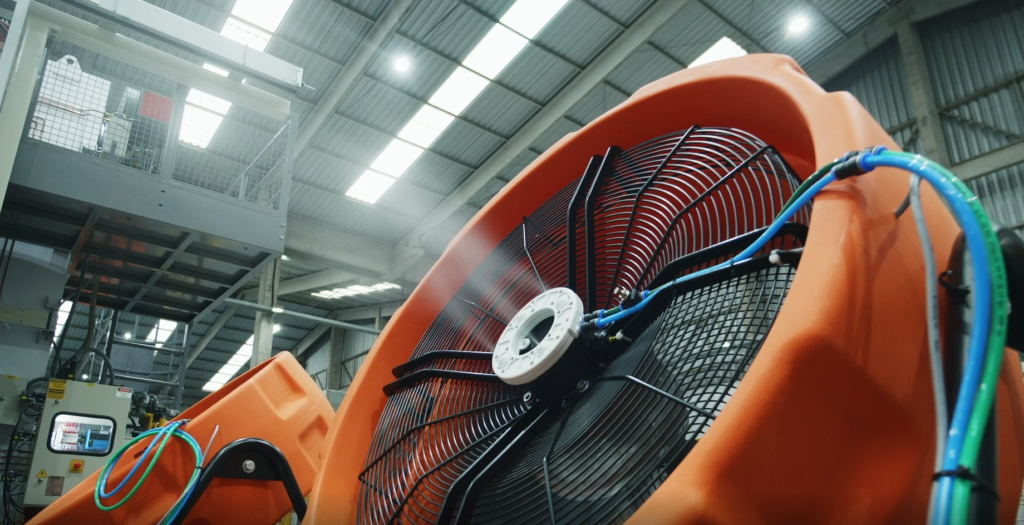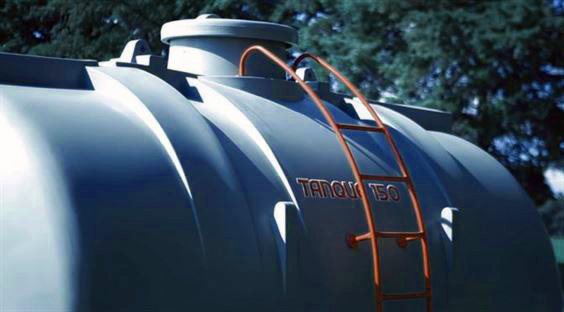Introduction
In the constant pulse of the industrial world, rotomolding in the tank industry emerges as a powerful revolution. This technique, combining efficiency and safety, is a game-changer in the field of chemical liquid storage. In this article, we will navigate the ocean of innovations in tank rotomolding, highlighting the benefits and advancements provided by this technique.
Rotomolding directs the production of storage tanks with precision. In this industrial context, the spotlight is on performance: tank durability, the safety of stored content, and, above all, the efficiency of the process are crucial elements of this operation.
Introduction to Rotomolding in Storage Tanks
When we talk about the manufacture of storage tanks by rotomolding, we are referring to an innovative process that has revolutionized the industry. Although rotomolding may seem like a complex technical term, its essence is quite simple and effective.
A Rotomoldingor rotational molding, is a production process that involves heating a plastic material in a rotating mold. The material is then heated and cooled, resulting in a seamless, high-quality single-piece product. In the realm of storage tank manufacturing, this technique has been adopted for its undeniable advantages over other production methods.
Chemical Industry Also Benefits
The Rotomolded tanks for chemicals for example, exhibit remarkable resistance and durability. Thanks to the nature of the rotomolding process, the produced tanks are solid and robust, capable of withstanding adverse conditions and resisting corrosion. This makes them ideal for the safe storage of chemical liquids.
- Resistance: The ability of rotomolded tanks to resist adverse conditions and aggressive chemicals is one of their main advantages. This is thanks to the rotomolding process, which results in a seamless and unified product, making them more resistant to breaks and leaks.
- Durability: Rotomolding produces tanks that are strong and durable. Unlike other production processes, rotomolding does not require welds or joints, eliminating weak points in the final product. This is a crucial factor for the safe and effective storage of chemicals.
Additionally, the flexibility of rotomolding allows for a wide variety of designs and sizes, making it possible to produce custom storage tanks to meet specific industry requirements.
In this article, we will delve into the wonders of rotomolding in the context of storage tank manufacturing. From material selection to advanced molding techniques, we aim to provide a glimpse of how revolutionary this technique has been for the industry. Keep in mind, however, that many aspects contribute to the efficiency and safety of rotomolded storage tanks, and it is the proper understanding and application of these that ensure the success of this process.
Material Selection: ensuring strength and durability
The manufacture of storage tanks by rotomolding is a process that heavily depends on the meticulous selection of raw materials. This step is crucial to ensuring the strength and durability of the tanks.
Choosing the right material is not a simple task; it requires the consideration of various factors such as the type of product to be stored, operating temperature, required chemical resistance, among others. There are several material options available, each with its own characteristics and benefits.
- High-Density Polyethylene (HDPE): This is one of the most commonly used materials in the manufacture of rotomolded tanks. HDPE is known for its exceptional chemical resistance, impact resistance, and durability. Additionally, it is recyclable, contributing to the sustainability of production.
- Polypropylene (PP): Very similar to HDPE in terms of chemical resistance, PP is a lighter and more flexible material. It is an excellent choice for applications requiring high temperature resistance.
- PVC: This material is well-known for its strength and corrosion resistance. However, it is not as resistant to high temperatures as PP or HDPE.
The proper choice of materials is essential to ensure the long life and efficient performance of rotomolded tanks. The chemical resistance of the selected materials must match the type of product to be stored to prevent tank degradation and contamination of the stored product. Additionally, materials must be able to withstand operating conditions, such as exposure to UV light and temperature variations.
Quality Control of Raw Materials
This is where quality control in rotomolded tanks comes in. Manufacturers need to ensure that the materials used meet the highest quality standards and are suitable for the intended use. Quality control procedures include testing chemical resistance, impact resistance, temperature resistance, and other relevant properties.
In summary, material selection is a fundamental part of rotomolded tank manufacturing. By choosing the right materials, manufacturers can ensure that the produced tanks are not only strong and durable but also safe and efficient for the storage of chemical liquids.
Energy Efficiency in Rotomolded Tank Production
A Rotomolding not only revolutionizes the production of storage tanks in terms of quality and durability but also in terms of energy efficiency. This section will address the unparalleled energy advantages of rotomolding and how they contribute to sustainability in the industry.
It is no secret that the manufacturing industry is a major energy consumer. However, rotomolding stands out as a light at the end of the energy tunnel, thanks to its plastic transformation method. Unlike other production techniques that require high temperatures and significant energy consumption, rotomolding uses a much more efficient process.
Controlled Heating
Rotomolding uses uniform and controlled heating, resulting in much more effective heat diffusion. This, in turn, reduces the amount of energy energy needed for tank production.
Efficient Molding
During heating, the plastic is rotated around a central axis. This ensures a homogeneous distribution of the material, eliminating the need for additional energy for tank shaping.
Programmed Cooling
The cooling process in rotomolding is also optimized to save energy. Unlike other production processes, cooling in rotomolding occurs gradually, avoiding thermal shock and the energy demand that it requires.

Thus, rotomolding goes beyond mere production of high-quality products. It also positions itself as a viable energy solution in an increasingly environmentally conscious world. The ability of rotomolding to reduce energy consumption without compromising product quality is a true revolution in the storage tank manufacturing industry.
Sustainable Process
Furthermore, the energy efficiency of rotomolding has a significant impact on sustainability. Less energy used means fewer carbon emissions, contributing to the reduction of the storage industry's carbon footprint. This not only benefits the environment but also enhances the company's image in an increasingly environmentally aware society.
In summary, rotomolding is an innovative example of how technology and environmental awareness can go hand in hand. This energy-efficient production process not only provides high-quality storage tanks but also contributes to building a more sustainable and responsible industry.
Quality Control Ensuring Safety in Storage
Safety is a primary concern when it comes to storing chemical liquids, and quality control is the guardian that ensures this safety. In the context of Rotomolding, quality control plays an even more crucial role, ensuring that each produced tank meets the industry's demands and customer expectations.
When we talk about quality control in the manufacturing of tanks by rotomolding, we are talking about a rigorous, meticulous, and continuous process. It starts with material selection, goes through molding, and reaches the final product inspection. Each step of this process is important and contributes to the tank's final quality.
Material Selection
As mentioned at the beginning of the article, choosing the right materials is the first step to ensure tank quality. The materials used must be resistant to chemicals and thermal conditions to ensure safety in storing chemical liquids. Quality control is responsible for checking the origin and characteristics of the materials used, ensuring they meet the necessary specifications.
Molding Process
During the molding process, it is crucial to ensure quality control, ensuring precision in rotation, heating, and cooling control. This ensures that the tank is molded correctly, without flaws or defects that could compromise its strength or durability.
Final Inspection
After the tank is produced, a final inspection is carried out, where the tank is rigorously checked to ensure it has no faults or defects. Resistance and durability tests are also conducted to ensure the tank is fit for the safe storage of chemical liquids.
Additionally, rotomolding allows for more precise and reliable production in terms of quality. Thanks to its versatile nature, rotomolding allows the production of complex tanks with various shapes and sizes without compromising the final product's quality.
In summary, quality control in the manufacturing of tanks by rotomolding is a rigorous and continuous process that ensures safety and efficiency in the storage of chemical liquids. It contributes to the industry's credibility and customer trust, ensuring that each produced tank is of high quality and safe for use.
Specific Applications: Tanks for Aggressive Chemicals
When addressing the universe of aggressive chemicals, there is an urgent need to discuss safety and efficiency in storing these elements. It is in this context that storage tanks produced by Rotomolding reveal themselves as indispensable allies in the chemical industry.
Rotomolding allows the manufacture of tanks with specific characteristics, optimized for the safe storage of aggressive chemical substances. These products, which can be both corrosive and flammable, require an extra level of caution and precision in the storage process.
In choosing materials for these tanks, chemical resistance presents itself as an indispensable quality. Polymers used in the rotomolding process, such as high-density polyethylene (HDPE), are known for their resistance to a variety of chemicals, making them an ideal option for such applications.
The way rotomolding can adjust the thickness of the tank according to specific needs is also a relevant factor. This ensures a uniform tank wall, eliminating weak points or seams that could become vulnerable to pressure or impact.
Example 1
Storage tanks for acids, such as sulfuric acid, which is extremely corrosive, greatly benefit from rotomolding. The use of resistant polymers and seamless construction ensures that these tanks can withstand the acid without suffering damage or leaks.
Example 2
In the oil and gas sector, companies use rotomolded tanks to safely store fuels. Rotomolding provides important features in this case, such as impact resistance and the ability to withstand temperature variations.
The benefits of rotomolded storage tanks for aggressive chemicals extend beyond safety and efficiency in terms of storage.
The resistance of materials and the quality of molding provide durability to these tanks, resulting in a long lifespan. This reduces the need for frequent replacements and contributes to sustainability in the industry.
Sustainability in Production
A Sustainability in the storage tank industry is an increasingly important issue. With the rotomolding process, we are taking a significant step toward more responsible and environmentally conscious production.
Firstly, rotomolding offers significant advantages in terms of energy efficiency. This translates to less energy consumption and a reduced carbon footprint. Additionally, the ability to use recycled materials in the process is a huge advantage for waste management.
- Reduced Energy Consumption: The rotomolding process consumes less energy compared to other production techniques, contributing to the overall reduction of energy consumption.
- Use of Recycled Materials: The rotomolding process allows the use of recycled materials, which is beneficial for effective waste management.
Thus, the manufacture of storage tanks through rotomolding demonstrates a commitment to sustainability and environmental responsibility..





